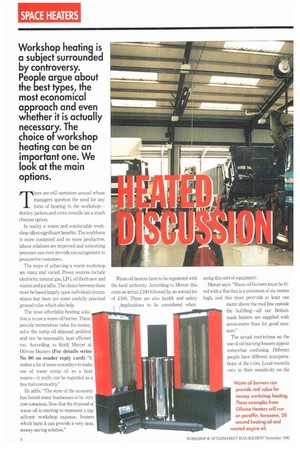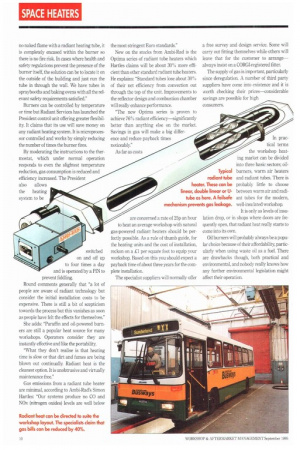T here are still operators around whose managers question the need
Page 100

Page 101

Page 102

If you've noticed an error in this article please click here to report it so we can fix it.
for any form of heating in the workshop— donkey jackets and extra overalls are a much cheaper option.
In reality a warm and comfortable workshop offers significant benefits The workforce is more contented and so more productive, labour relations are improved and welcoming premises can even provide encouragement to prospective customers.
The ways of achieving a warm workshop are many and varied. Power sources include electricity, natural gas, LPG, oil (both new and waste) and paraffin. The choice between these must be based largely upon individual circumstance but there are some usefully practical ground rules which also help.
The most affordable heating solution is to use a waste oil burner. These provide tremendous value for money, solve the sump oil disposal problem and can be reasonably heat efficient too. According to Keith Mercer at Oilwise Heaters (For details write No 80 on reader reply card): "It makes a lot of sense nowadays to make use of waste sump oil as a heat source—it really can be regarded as a free fuel commodity."
He adds: "The state of the economy has forced many businesses to be very cost conscious. Now that the disposal of waste oil is starting to represent a significant workshop expense, heaters which burn it can provide a very neat, money-saving solution." Waste oil heaters have to be registered with the local authority. According to Mercer this costs an initial £100 followed by an annual fee of £100. There are also health and safety • implications to be considered when using this sort of equipment.
Mercer says: "Waste oil burners must be fitted with a flue that is a minimum of six metres high, and this must protrude at least one metre above the roof line outside the building—all our Britishmade heaters are supplied with seven-metre flues for good measure."
The actual restrictions on the use of oil-burning heaters appear somewhat confusing. Different people have different interpretations of the rules. Local councils vary in their sensitivity on the subject but most agree that if the unit is made to the recognised BS 4256 standard, is maintained and serviced correctly and that registration has been sought, then there should be few problems.
Poorly maintained oil-burning heaters will smoke which, in turn will almost certainly alert the authorities and possibly infringe the Clean Air Act. Environmental issues are prominent at present and EPA inspectors will act decisively to correct anything they see as undesirable.
According to Salman Mehson of Kroll (UK) (Write No 79 on reader reply card) waste oil heaters really are big business. "We market a wide range of quality equipment imported from Germany, including gas and electric-powered heaters. The economics of oilburning appeal to the commercial vehicle market and since the forms were simplified recently, registration with the local authority is child's play."
Gas-powered burners and space heaters are another popular and traditional heating option but there can be associated dangers if they employ exposed flames. Common sense is required with their location and areas with high concentrations of solvent of fuel vapour make obviously bad siting-s.
The positioning of warm air heaters is important to minimise the risk of explosion and prevent the stirring up of vapour-laden air. Simon Hartles of Halesowen-based AmbiRad (Write No 78 on reader reply card) comments: "The presence of heavier-than-air fuel vapour in the workshop environment can pose real problems.
"The legislation within the EPA governing the use of these machines has been tightened significantly Warm air appliances have to be mounted above a certain minimum height which effectively rules out a number of the older design cabinet heaters."
He continues: "Many workshop managers I have spoken to are still using waste oil burners in ways which are infringing the rules although they realise that compliance with the new regs, will be forced upon them in due course."
The one problem with all forms of hot air heating is that they rely on warming the whole air space for their effect, This is an inherently inefficient objective. Hot air rises and so all of it will eventually end up in the roof space where it is of no value at all.
Commercial shops often have larger than normal doors which are usually open more than they are closed. This leads to significant additional hot air loss and compounds the problem.
Hartles believes that many businesses are pouring money down the drain by trying to heat elderly, leaky workshops with warm air machines—leaking roof lights will consume rising hot air as fast as the heater can produce it. He thinks radiant tube heating is the most efficient and effective solution.
The effect is similar to that of the sun. Heat generated from the roof-mounted tubes is felt by the occupants of the workshop while the air itself is not heated. Hartles says: "The big advantages of radiant heat are its efficiency because the system is not attempting to heat the entire volume of air, the complete lack of air movement to disturb dirt, dust and other contaminants plus the significant feel-good factor.
"Because the air itself is not directly heated it remains fresh and there is no hint of the stuffiness which can be associated with other forms of heating. The technique is well suited to open-door environments too because the flow of air around the workshop makes no difference to the heating effect."
Radiant heating tubes are powered by either natural gas or LPG, depending upon the supply situation. A thermostatically controlled burner at one end of a metal tube fires a flame while an extractor fan at the other end creates a partial vacuum to draw the hot air down the length of the tube and ensure even heating.
Exhausted air can either be routed out through the roof via a flue or allowed straight into the air space within the workshop— depending upon the type of building. New structures, which tend to be more draught proof, usually require a flue.
June Round of Radiant Services (Write No 84 on reader reply card) adds: "There is no naked flame with a radiant heating tube, it is completely encased within the burner so there is no fire risk. In cases where health and safety regulations prevent the presence of the burner itself, the solution can be to locate it on the outside of the building and just run the tube in through the wall We have tubes in spraybooths and baking ovens with all the relevant safety requirements satisfied."
Burners can be controlled by temperature or time but Radiant Services has launched the President control unit offering greater flexibility. It claims that its use will save money on any radiant heating system. It is microprocessor controlled and works by simply reducing the number of times the burner fires.
By moderating the instructions to the thermostat, which under normal operation responds to even the slightest temperature reduction, gas consumption is reduced and efficiency increased. The President also allows the heating system to be switched on and off up to four times a day and is operated by a PIN to prevent fiddling.
Round comments generally that "a lot of people are aware of radiant technology but consider the initial installation costs to be expensive. There is still a bit of scepticism towards the process but this vanishes as soon as people have felt the effects for themselves."
She adds: "Paraffin and oil-powered burners are still a popular heat source for many workshops. Operators consider they are instantly effective and like the portability.
"What they don't realise is that heating time is slow or that dirt and fumes are being blown out continually. Radiant heat is the cleanest option. It is unobtrusive and virtually maintenance free."
Gas emissions from a radiant tube heater are minimal, according to Ambi-Racl's Simon Hartles: "Our systems produce no CO and NOx (nitrogen oxides) levels are well below the most stringent Euro standards."
New on the stocks from Ambi-Rad is the Optima series of radiant tube heaters which Hartles claims will be about 30% more effident than other standard radiant tube heaters. He explains: "Standard tubes lose about 30% of their net efficiency from convection out through the top of the unit. Improvements to the reflector design and combustion chamber will really enhance performance.
"The new Optima series is proven to achieve 76% radiant efficiency—significantly better than anything else on the market. Savings in gas will make a big difference and reduce payback times noticeably."
As far as costs are concerned a rate of 25p an hour to heat an average workshop with natural gas-powered radiant heaters should be perfectly possible. As a rule of thumb guide, for the heating units and the cost of installation, reckon on a El per square foot to equip your workshop. Based on this you should expect a payback time of about three years for the complete installation.
The specialist suppliers will normally offer a free survey and design service. Some will carry out fitting themselves while others will leave that for the customer to arrange— always insist on a CORGI-registered fitter.
The supply of gas is important, particularly since deregulation. A number of third party suppliers have come into existence and it is worth checking their prices—considerable savings are possible for high consumers. In practical terms the workshop heating market can be divided into three basic sectors; oilburners, warm air heaters and radiant tubes. There is probably little to choose between warm air and radiant tubes for the modern, well-insulated workshop.
It is only as levels of insulation drop, or in shops where doors are frequently open, that radiant heat really starts to come into its own.
Oil burners will probably always be a popular choice because of their affordability, particularly when using waste oil as a fuel. There are drawbacks though, both practical and environmental, and nobody really knows how any further environmental legislation might affect their operation.




















































































































